
Former EBCLC Staff Attorney and Clinical Supervisor, Anavictoria Avila, led the project from the early design stages to the final strokes. We sat down with her to learn more about her vision and the meaning behind the imagery on the mural:
1) Can you talk through each panel of the mural and why you made the choices you did (an intergenerational Black family playing music, a Trans Liberation flag…)?
The artwork is my interpretation of community resistance against displacement, so I wanted to represent layers of what makes up a community through a lot of symbolic and identity-specific imagery.
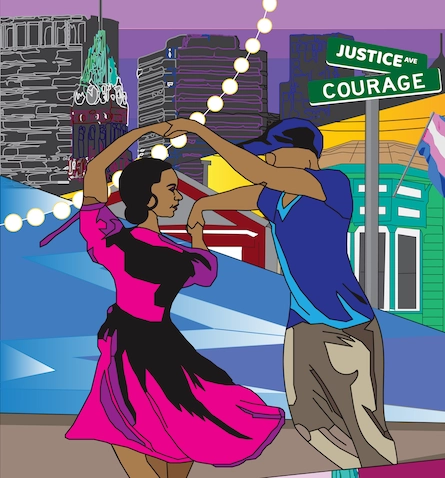
Layers of a Community: The first layer represents the home, the second layer is the neighborhood and community, and the third layer is the city, which is represented here through the Oakland skyline merging with the Lake Merritt imagery.
Justice and Courage Avenue: This image is a symbolic crossroads that I felt EBCLC staff chose on a daily basis during my time working for EBCLC. In our work at Education Defense and Justice for Youth Program (EDJY), we often felt that all the odds were stacked up against us, especially in education defense work. We had many avenues or options we could take to either give up or choose to fight harder. We always chose to fight harder; I felt the only roads we were willing to take were of Justice and Courage.
Couple dancing: This image is symbolic of community resistance and connection through dance. I am quite the dancer myself, and this was inspired by “Salsa by the Lake,” which was a community event that usually happened once a month at Lake Merritt pre-COVID times. It represents joy in the midst of displacement. This form of community expression sends a message that “hey, we are here, we belong here, this is our home, and we bring beauty, color, and life-giving energy to spaces as we dance.”

Trans Pride Flag: This image represents intersectional identities through the home, specifically for the transgender community. Pre-COVID times, but now exacerbated through the injustices of the pandemic and displacement, I know that the transgender community, notably transgender communities of color, have suffered a lot from the housing crisis in the Bay Area. The Trans Pride flag mounted on the house represents presence, home ownership, safe visibility, and the symbolic message of “this is our home.”
Woman holding Pride Flag: I wanted to represent the Indigenous community, because when I think about displacement, Indigenous nations have suffered and overcome some of the most violent and oppressive forms of displacement throughout history and present day. Berkeley and most of the Bay Area is on Ohlone land. I also wanted to represent intersectional identity and the presence of the LGBTQ community, specifically through an Indigenous woman. Furthermore, Ohlone women have worked really hard to bring forth the rights, traditions, education, and advancement of the Ohlone people in the Bay Area, so it was important to me for this identity to be present here.
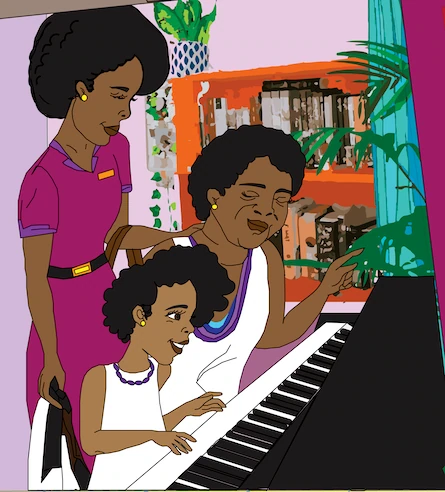
Three Generations: In general, for me, the concept of three generations is very powerful. I wanted to portray the strength that Black women bring across generations through the connection shown here between the grandmother, mother, and daughter as they create music. The concept is also important to me as a lawyer and policy advocate, because I’ve experienced that intergenerational community organizing is a powerful force against systemic injustice. When we organize with families through generations, it allows for the family to come together and unite against a system that often pits families against one another and causes further harm.
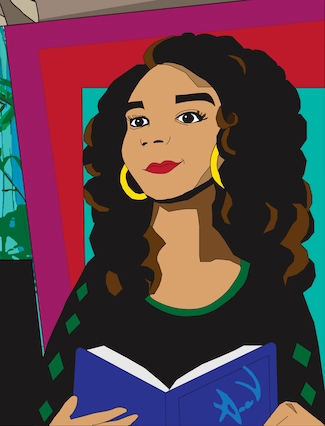
Young girl with book: I’ve seen how hard vulnerable and marginalized families work to create a home where their children can learn and be safe. This image represents imagination and vision through the lens of a young woman of color. I specifically wanted to represent an Afro-Latina to represent the diversity of the Bay Area and the fact that Afro-Latinidad is an identity that is often erased when speaking about Latinx issues.
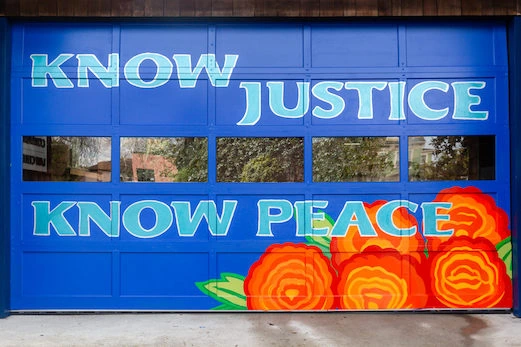
Marigolds on the garage door: For the garage door, I depicted the marigold flowers, because my artistic style is very much inspired by my Mexican identity and roots. The marigold flowers are an important symbol used every year on alters, doorways, arches, and ceremonies during Dia De Los Muertos—the spiritual holiday rooted in Mesoamerican Indigenous traditions Mexican communities in the U.S., and throughout Latin America gather to honor loved ones who have passed away. The significance of the flower is that the marigold’s color and scent calls onto our ancestors to be present with us at their respective altars and homes.
“Know Justice, Know Peace” on the garage door: EBCLC’s Executive Director, Zoë Polk, had the idea of incorporating “Know Justice, Know Peace,” because we knew we wanted a powerful statement on the garage door that would represent what EBCLC stands for. I love that Zoë chose this slogan, given the significance of the phrase’s connection with “No Justice, No Peace” in the ongoing Black Lives Matter movement, and its resurgence over the summer. “Know Justice, Know Peace” has a lot of historical and contemporary meaning, so it fits perfectly with the ancestral and entry symbolism of the garage door; and that is how the design all came together.
2) What is the inspiration behind the piece?
The inspiration behind the piece is displacement. What also inspired the artwork is the community resistance, diversity, culture, strength, and vibrancy of the Bay Area generally, and Oakland. Oakland is represented through the architecture of the homes, Lake Merritt, and the city skyline. Because many of EBCLC’s clients are from Oakland, I wanted to represent a vision of home, community, culture, dancing, intersectional identities, and all the joy that is still present in the Bay Area and Oakland.
3) What is your vision for the mural and its purpose in the larger South Berkeley community?
My vision for this mural is for it to keep bringing smiles, joy, and inspiration to the EBCLC and local community. My intention is that it will motivate people to engage with the imagery and want to learn more about EBCLC, its staff, and the important work each unit does. My intention is also for the mural to be a daily reminder of hope and empowerment, for impacted community members to feel seen and represented; I also hope that people will feel an energy boost from interacting with its colorful imagery and meaning.
4) As a former EDJY staff member, what does it mean for you to bring this artwork to EBCLC?
I know how hard EBCLC’s staff work to bring essential legal services to the community, which has been significantly more challenging throughout the pandemic. I am happy to bring a colorful and meaningful art piece to EBCLC’s space. I also feel like I’m back at EBCLC. It was a hard decision for me to leave EDJY when I did, and I will always appreciate EBCLC’s and EDJY’s daily work. The mural has created a bridge back to EBCLC, which makes me feel forever a part of this community.
5) What is the importance of art during the current times?
There’s significant importance on an individual, community, and national level. On a national level, we keep hearing that the pandemic, 2020, and the injustices and circumstances of the last four years have pushed us all, some more than others, to re-imagine everything. Re-imagining calls for creativity, so this has been a unique and challenging era for artists of all mediums. On a community level, in general, art is a form of representation, an expression of identity, culture, or experience, and it has the power to make strong statements. When you see art, like a mural, it has the power to make you think critically, and also has the power to make you feel at ease, understood, inspired, angered, seen, or heard depending on the colors, texture, size, and imagery. Mural art is really important during these times because it confronts the public with a larger discussion around identity and social justice. Murals, and art in general, have the power to bring to the forefront important messages on societal and community issues. On an individual level, art is very healing and therapeutic.
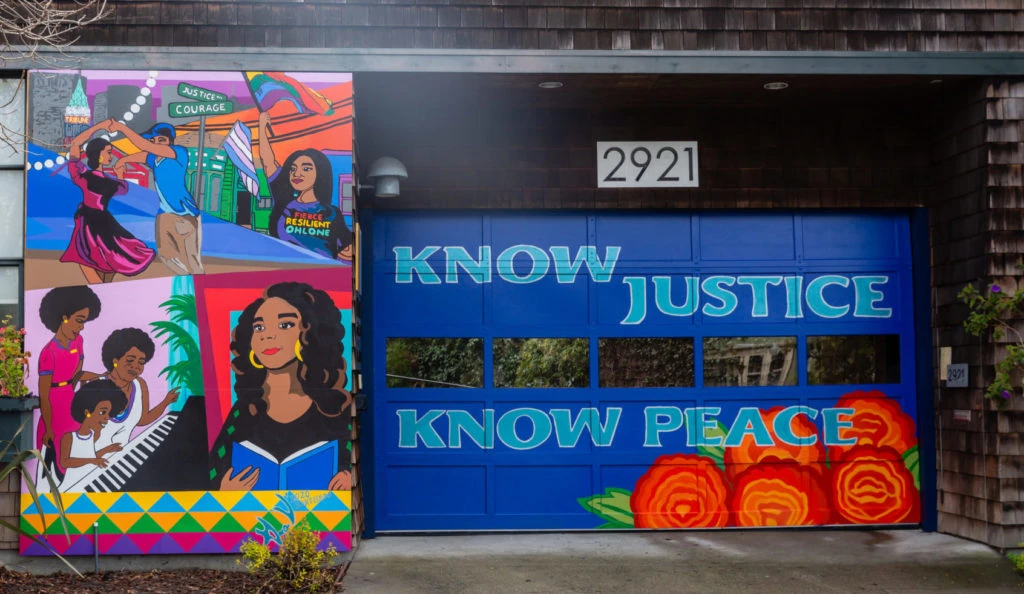
Learn more about Anavictoria Avila and her artwork on her website or visit her Instagram.